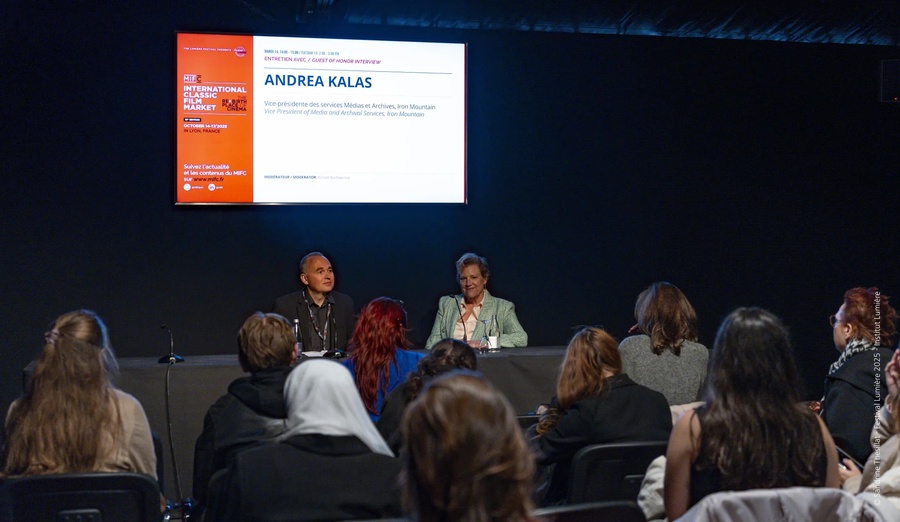GUEST OF HONOR INTERVIEW : Andrea Kalas
The Guest of Honor at the Marché International du Film Classique (MIFC - International Classic Film Market), archivist Andrea Kalas, who transitioned from Paramount Studios to Iron Mountain, where she now serves as Vice President of Media and Archive Services, shared her career path, her greatest achievements—notably the restoration of The Godfather saga—and her vision of the major challenges posed by audiovisual preservation and the digital era during a masterclass led by Gérald Duchaussoy, co-head of the MIFC.

1. The New Role and Innovation
-
Current Function: At Iron Mountain, Andrea oversees Media and Archive Services, managing the preservation of various archives (audiovisual, costumes, etc.).
-
Mission: To help clients (including major studios) care for their collections, ranging from scanning to video/film digitization.
-
Key Innovation: The team created the Archive Explorer, a machine that quickly captures and digitizes inventory information from objects or boxes (via OCR), essential for uncatalogued collections.
2. Major Projects and Physical Preservation
-
Cold Vaults: The priority project is the construction of cold vaults (in the United States and the United Kingdom) for film storage. The reason: below-freezing temperatures are vital to halt the deterioration of acetate-based films and extend their lifespan.
-
Digitization Centers: The company operates digitization centers (studios) and can deploy standardized working environments and train teams at client sites worldwide.
3. Career Path and Key Achievements
Andrea’s career is marked by success in major institutions, including UCLA, the British Film Institute (BFI), where she notably built a unique cold vault for nitrate and acetate films, and Paramount Pictures, where she expanded the archives and preserved rare films.
One of Andrea's greatest sources of pride during her tenure at Paramount was undoubtedly the supervision of the restoration of all three The Godfather films in anticipation of the saga's 50th anniversary in 2022. It was a huge challenge that began five years in advance to secure the necessary budget. The team undertook the restoration of all three installments simultaneously, focusing for the first two parts on finding every single fragment of the original negative, even if it was just a single frame, to compensate for damage accumulated through intensive use. The third film, meanwhile, was subject to a re-edit desired by Francis Ford Coppola, which involved close collaboration, facilitated by the COVID-19 period as the director was traveling less. Andrea nevertheless recalled that they took care to preserve the original version of the third film for historical purposes. The culmination of the project was marked by a private screening of the new edit to some of the cast, including Diane Keaton and Al Pacino, a very moving moment that testified to the deep personal impact of the work on those who participated in it. The success was confirmed when Coppola gave his final approval, and the work was crowned by a memorable screening on the beach at the Cannes Film Festival.
4. The Future and Archiving Challenges
-
Digital Preservation: Facing increasingly digital production, Andrea stressed the importance of digital preservation (integrity checks, protocols) and co-founded the Academy Digital Preservation Forum to share knowledge.
-
Challenges: Funding remains a major obstacle, as well as the urgent need to digitize obsolete video tapes and the integration of Artificial Intelligence (AI) for research and restoration.
-
Vision: Andrea views technological crises as catalysts that have led to an archiving revolution, hoping that the era of AI will enhance the recognition and use of archival heritage.




